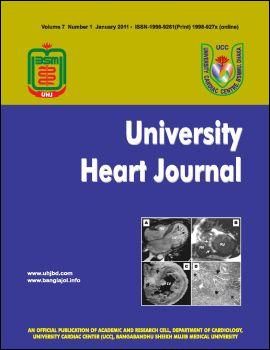A Comparative Study Between Conventional and Direct Stenting by Measuring Serum Cardiac Troponin-I
DOI:
https://doi.org/10.3329/uhj.v7i1.10206Keywords:
Conventional stenting, Direct stenting, Troponin-I.Abstract
The aim of the study is to assess serum Cardiac Troponin-I level in patients who have underdone Percutaneous coronary intervention (PCI) as an indication of myocardial injury and. Compare the troponin-I level in direct or conventional stetting in PCI and assess the superiorty of two methods of PCI, regarding myocardial injury and outcome. Cardiac Troponin-I (cTnI) is known to have the highest specificity & analytic sensitivity for detection of myocardial injury. This study was aimed to compare between conventional and direct stenting by assessing of serum cTnI. This observentional study was carried out in the Deparment of Biochemistry, Dhaka Medical College & Dept. of Cardiology, Ibrahim Cardiac Hospital and Research Institute during the period from July 2007 to June 2008. In this study we enrolled 60 diagnosed cases of coronary heart disease patients which were grouped as direct stenting (30 patients) and conventional stenting (30 patients) group. In this study, the age of the patients ranged from 42-72 years with a mean of 56.7 (±7.1) years. Male and female participants were 44 and 16 respectively. The mean left ventricular ejection fraction of them were 55.43 (±7.9) %. The difference of the mean troponin-I level before direct and conventional stenting was similar. Although the mean level of troponin-I after conventional stenting was higher (0.081± 0.042) than that of direct stenting (0.066±0.042), the difference of means was not statically significant (P> 0.05). Significant difference was observed between the mean before and after direct stenting as well as conventional stenting. From our observation we can conclude that serum cTnI level was higher after conventional stenting than that of direct stenting but the difference of means was not statically significant. It rises significantly after Percutaneous coronary intervention regardless of the type of procedure, whether direct or conventional stenting. Though the clinical outcome is reported to be similar in direct and conventional stenting, the direct stenting requires less procedural and equipment cost as well as less exposure time to radiation.
DOI: http://dx.doi.org/10.3329/uhj.v7i1.10206
UHJ 2011; 7(1): 23-27
Downloads
149
136

